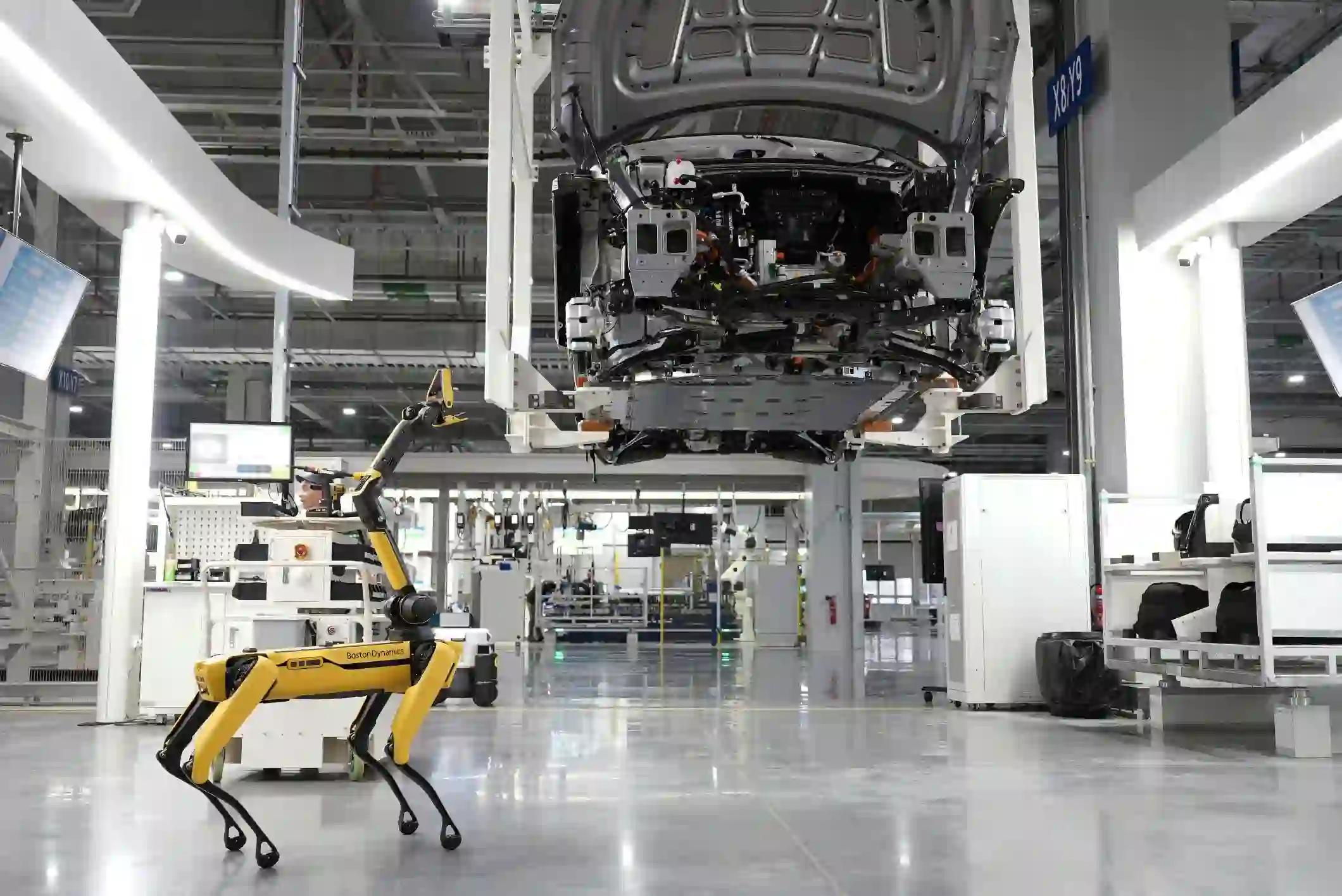Edge AI and Autonomous IoT Robotics in Smart Infrastructure


The convergence of edge computing, artificial intelligence, and autonomous robotics is transforming how we manage and maintain urban and industrial infrastructure. Recent studies indicate that smart infrastructure initiatives leveraging edge AI and robotics have achieved up to 30% reduction in energy consumption and 40% improvement in maintenance efficiency. This technological integration is particularly crucial as cities worldwide invest in smart infrastructure, with the market projected to reach $256 billion by 2025.
Edge AI Architecture in Autonomous Systems
Modern smart infrastructure relies on sophisticated edge computing architectures that enable real-time decision-making in autonomous robotic systems. At the heart of these systems lies a distributed computing framework that operates across multiple tiers. The key components of this framework include:
- Edge Nodes: Specialized processors that handle local computations directly on robotic devices, reducing latency and enabling rapid response
- Mesh Networks: Interconnected device systems that share processing loads and maintain operational resilience
- Hierarchical Processing: Multi-tier architecture that optimally balances local and centralized processing needs
The success of edge AI systems depends heavily on optimizing AI models for resource-constrained environments. This optimization process encompasses several critical approaches:
- Model Compression: Advanced techniques for running complex AI algorithms efficiently on edge devices
- Federated Learning: Distributed model training across edge devices while maintaining data privacy
- Dynamic Model Loading: Adaptive loading of AI models based on real-time operational requirements
Autonomous Robotics Applications
The implementation of autonomous robotics in smart infrastructure spans several critical areas, each addressing specific operational challenges. Infrastructure inspection represents one of the most successful applications, where specialized robots equipped with advanced sensing capabilities continuously monitor structural health and environmental conditions. These inspection systems utilize multiple sensing technologies:
- High-resolution visual inspection systems with computer vision algorithms
- Vibration and stress analysis sensors for structural health monitoring
- Environmental parameter sensors for air quality and condition assessment
Maintenance and repair systems have evolved to become increasingly autonomous, fundamentally changing how infrastructure is maintained. These systems employ AI-driven predictive maintenance algorithms that analyze data from multiple sources to anticipate potential failures before they occur. When issues are detected, automated repair systems can perform basic maintenance tasks, significantly reducing response times and maintenance costs.
Energy management represents another crucial application area where autonomous robots are making significant impacts. These systems provide several key capabilities:
- Real-time power distribution analysis and optimization
- Intelligent integration of renewable energy sources
- Automated demand response and load balancing
- Predictive maintenance of power infrastructure
Real-World Implementation Challenges
The deployment of edge AI-powered robotics in infrastructure faces several significant challenges that require careful consideration. Power management remains a critical concern, as autonomous systems must maintain continuous operation in various environmental conditions. This has led to innovations in energy harvesting and storage technologies, along with sophisticated power management algorithms.
Key implementation challenges include:
- Technical Constraints:
- Continuous power supply management
- Network reliability in complex environments
- System redundancy for critical operations
- Operational Requirements:
- Safety protocol implementation
- Regulatory compliance management
- Emergency response capabilities
Future Directions and Impact
The evolution of edge AI and autonomous robotics continues to push the boundaries of what's possible in smart infrastructure management. Recent developments have focused on several promising areas:
- Advanced Materials Integration:
- Smart materials with built-in sensing capabilities
- Self-healing infrastructure components
- Energy-harvesting surfaces
- Coordinated Robotics Systems:
- Swarm robotics for complex tasks
- Multi-robot coordination protocols
- Collaborative maintenance operations
The societal impact of these technological advances extends beyond operational efficiency. Enhanced urban resilience has become increasingly important as cities face growing challenges from climate change and aging infrastructure. Edge AI-powered systems provide the capability to quickly detect and respond to infrastructure issues, potentially preventing failures before they impact public safety.
Conclusion
Edge AI-powered autonomous robotics represents a fundamental shift in infrastructure management, enabling more efficient, resilient, and sustainable operations. As these technologies continue to mature, their integration into smart infrastructure will become increasingly crucial for meeting the challenges of urbanization and infrastructure modernization. Success in implementing these systems requires careful consideration of technical requirements, operational challenges, and societal impacts, along with a commitment to continuous innovation and adaptation. The future of smart infrastructure lies not just in the technology itself, but in how effectively we can harness it to create more livable and sustainable urban environments.
About the author

The Edge Review Technical Staff is a team of experienced analysts, writers, and industry experts dedicated to providing in-depth insights into emerging technologies, industry trends, and critical developments in the digital landscape. With a strong focus on AI, cybersecurity, fintech, and software engineering, the team combines technical expertise with journalistic rigor to deliver well-researched articles, reviews, and thought leadership pieces. Their work is aimed at helping professionals, businesses, and technology enthusiasts navigate the fast-evolving world of innovation with clarity and confidence.
At The Edge Review, we believe that groundbreaking ideas deserve a global platform. Through our multidisciplinary trade publication and journal, our mission is to amplify the voices of exceptional professionals and researchers, creating pathways for recognition and impact in an increasingly connected world.
Member%20--%3e%3c!DOCTYPE%20svg%20PUBLIC%20'-//W3C//DTD%20SVG%201.1//EN'%20'http://www.w3.org/Graphics/SVG/1.1/DTD/svg11.dtd'%3e%3csvg%20version='1.1'%20id='Layer_1'%20xmlns='http://www.w3.org/2000/svg'%20xmlns:xlink='http://www.w3.org/1999/xlink'%20x='0px'%20y='0px'%20viewBox='0%200%20200%2067.9'%20style='enable-background:new%200%200%20200%2067.9;'%20xml:space='preserve'%3e%3cstyle%20type='text/css'%3e%20.st0{fill:%234F5858;}%20.st1{fill:%233EB1C8;}%20.st2{fill:%23D8D2C4;}%20.st3{fill:%23FFC72C;}%20.st4{fill:%23EF3340;}%20%3c/style%3e%3cg%3e%3cg%3e%3cg%3e%3cg%3e%3cpath%20class='st0'%20d='M76.1,37.5c-0.4-2.6-2.9-4.6-5.8-4.6c-5.2,0-7.2,4.4-7.2,9.1c0,4.4,2,8.9,7.2,8.9c3.6,0,5.6-2.4,6-5.9H82%20c-0.6,6.6-5.1,10.8-11.6,10.8c-8.2,0-13-6.1-13-13.7c0-7.9,4.8-14,13-14c5.8,0,10.7,3.4,11.4,9.5H76.1z'/%3e%3cpath%20class='st0'%20d='M84,35.9h5v3.6h0.1c1-2.4,3.6-4.1,6.1-4.1c0.4,0,0.8,0.1,1.1,0.2v4.9c-0.5-0.1-1.3-0.2-1.9-0.2%20c-3.9,0-5.2,2.8-5.2,6.1v8.6H84V35.9z'/%3e%3cpath%20class='st0'%20d='M106.4,35.4c6,0,9.9,4,9.9,10.1c0,6.1-3.9,10.1-9.9,10.1c-6,0-9.9-4-9.9-10.1%20C96.5,39.4,100.4,35.4,106.4,35.4z%20M106.4,51.6c3.6,0,4.7-3.1,4.7-6.1c0-3.1-1.1-6.1-4.7-6.1c-3.6,0-4.6,3.1-4.6,6.1%20C101.8,48.6,102.8,51.6,106.4,51.6z'/%3e%3cpath%20class='st0'%20d='M122.4,48.9c0,2.3,2,3.2,4,3.2c1.5,0,3.4-0.6,3.4-2.4c0-1.6-2.2-2.1-6-3c-3-0.7-6.1-1.7-6.1-5.1%20c0-4.9,4.2-6.1,8.3-6.1c4.2,0,8,1.4,8.4,6.1h-5c-0.1-2-1.7-2.6-3.6-2.6c-1.2,0-2.9,0.2-2.9,1.8c0,1.9,3,2.1,6,2.9%20c3.1,0.7,6.1,1.8,6.1,5.4c0,5-4.4,6.7-8.7,6.7c-4.4,0-8.8-1.7-9-6.7H122.4z'/%3e%3cpath%20class='st0'%20d='M141.6,48.9c0,2.3,2,3.2,4,3.2c1.5,0,3.4-0.6,3.4-2.4c0-1.6-2.2-2.1-6-3c-3-0.7-6.1-1.7-6.1-5.1%20c0-4.9,4.2-6.1,8.3-6.1c4.2,0,8,1.4,8.4,6.1h-5c-0.1-2-1.7-2.6-3.6-2.6c-1.2,0-2.9,0.2-2.9,1.8c0,1.9,3,2.1,6,2.9%20c3.1,0.7,6.1,1.8,6.1,5.4c0,5-4.4,6.7-8.7,6.7c-4.4,0-8.8-1.7-9-6.7H141.6z'/%3e%3cpath%20class='st0'%20d='M156.1,35.9h5v3.6h0.1c1-2.4,3.6-4.1,6.1-4.1c0.4,0,0.8,0.1,1.1,0.2v4.9c-0.5-0.1-1.3-0.2-1.9-0.2%20c-3.9,0-5.2,2.8-5.2,6.1v8.6h-5.3V35.9z'/%3e%3cpath%20class='st0'%20d='M174.2,46.8c0.1,3.3,1.8,4.9,4.7,4.9c2.1,0,3.8-1.3,4.1-2.5h4.6c-1.5,4.5-4.6,6.4-9,6.4%20c-6,0-9.8-4.1-9.8-10.1c0-5.7,4-10.1,9.8-10.1c6.5,0,9.7,5.5,9.3,11.4H174.2z%20M182.7,43.5c-0.5-2.7-1.6-4.1-4.2-4.1%20c-3.3,0-4.3,2.6-4.4,4.1H182.7z'/%3e%3cpath%20class='st0'%20d='M190.9,39.5h-3.1v-3.5h3.1v-1.5c0-3.4,2.1-5.8,6.4-5.8c0.9,0,1.9,0.1,2.8,0.1v3.9c-0.6-0.1-1.3-0.1-1.9-0.1%20c-1.4,0-2,0.6-2,2.2v1.1h3.6v3.5h-3.6v15.6h-5.3V39.5z'/%3e%3c/g%3e%3c/g%3e%3c/g%3e%3c/g%3e%3cpolygon%20class='st1'%20points='0,67.9%200,47.4%2016.8,41.9%2046.6,52.1%20'/%3e%3cpolygon%20class='st2'%20points='29.8,26.1%200,36.4%2016.8,41.9%2046.6,31.7%20'/%3e%3cpolygon%20class='st0'%20points='16.8,41.9%2046.6,31.7%2046.6,52.1%20'/%3e%3cpolygon%20class='st3'%20points='46.6,0.2%2046.6,20.6%2029.8,26.1%200,15.9%20'/%3e%3cpolygon%20class='st4'%20points='29.8,26.1%200,36.4%200,15.9%20'/%3e%3c/svg%3e)
Important Links
Contact Info
info@theedgereview.org
Address:
14781 Pomerado Rd #370, Poway, CA 92064
